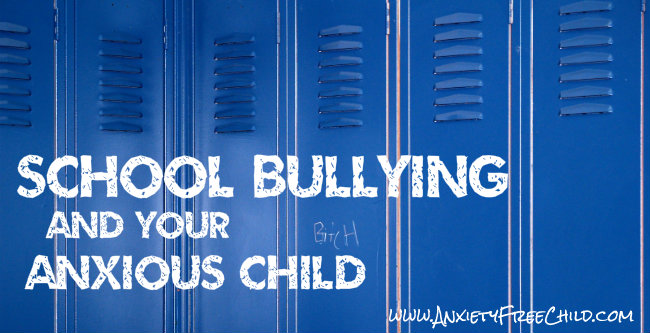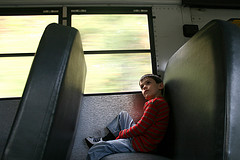 This post the second installment in our three-part series on bullying and your anxious child. Click here to read part 1.
This post the second installment in our three-part series on bullying and your anxious child. Click here to read part 1.
It may be bad when your anxious child comes home from school with a D in math or the flu, but they may be even worse off when they come home after being bullied.
In fact, the bullying may contribute big time to the D by diminishing your child’s school performance, according to a National Center for School Engagement study. Bullying can even be indirectly linked to the flu by creating stress that weakens immune system, says the American Psychological Association. And that’s just a couple of the negative side effects.
As you learned in our previous overview on bullying, bullies often target anxious children to begin with and the process can develop into a vicious cycle that continues to annihilate your child’s mental and even physical health. This post discusses bullying at schools and what both school administration and parents can do to address it.
If you don’t think bullying is an issue at your child’s school, perhaps a glance at some statistics from StompOutBullying.org will change your mind.
Bullying at School by the Numbers
- 160,000 – kids who stay out of school each day because they’re afraid of being bullied
- 85 – percentage of bullying that takes place in school as compared to other locations
- 81 – percentage of acts of bullying that are never reported to adults
- 71 – percentage of kids who admit bullying is an issue at their school
- 56 – percentage of students who have been bullied, with 31 percent bullied by a classmate
- 43 – percentage of middle school kids who have threatened to hurt another student
- 43 – percentage of student who fear harassment in the school bathroom
- 42 – percentage of students who have bullied someone
- 20 – percentage of high school students who have been bullied in school in the past year
- 10 – percentage of kids who drop out of school because of repeated bullying
Dropping out and school refusal join bad grades and physical maladies as the long list of symptoms that can crop up as a result from bullying. One more eye-opening stat comes from just outside the school but likely during school hours:
“Every 7 minutes a child is bullied on the playground,” according to the Stomp Out Bullying program. “More youth violence occurs on school grounds as opposed to on the way to school”
![]() Tweetable:
Tweetable:
160,000 kids stay out of school daily because of bullying [tweet this]
Anxious Children and School Bullies
While you know your anxious child is at an increased risk of being bullied due to the simple fact that he or she suffers from anxiety issues, there are other contributing factors on school grounds. Previous incidents of being bullied play a role, as does an impulsive nature. Students who have low self-esteem or trouble making friends are often victims of bullies, and students can become victims if they are typically quiet and reserved.
Bullying Starting in Preschool? You Bet
 Bullies don’t take their time picking out their victims, either, as a study in BMC Public Health points out. The study examined children aged 4 to 5, or those at the preschool level, to help determine where and how bullying originated. The study found preschoolers who had good motor skills were less likely to be victims of bullies but more likely to become bullies than those with poorer skills.
Bullies don’t take their time picking out their victims, either, as a study in BMC Public Health points out. The study examined children aged 4 to 5, or those at the preschool level, to help determine where and how bullying originated. The study found preschoolers who had good motor skills were less likely to be victims of bullies but more likely to become bullies than those with poorer skills.
It also uncovered various traits that make children more likely to be victims, bullies, or both bully and victim in later years. These traits included aggressiveness, being in families with low socioeconomic status, coming from broken homes, and having emotional or preschool behavioral problems.
The study suggested paying immediate attention to the mental health issues that are linked to bullying may help deter both bullying and victimization down the road. Once that road has been traveled, however, there are still things both schools and parents can do to help stop or prevent the continuation of the cycle.
![]() Tweetable:
Tweetable:
Bullying is now being seen as early as PRESCHOOL [tweet this]
School Bullying Programs that Work
A report put together for the Swedish National Council for Crime Prevention examined 59 anti-bullying programs in schools across the U.S. and other countries to determine which were most effective. Here’s what they found worked best:
- School strategies that included school conferences, bullying discipline and improved playground supervision
- Teacher classroom strategies, such as clear bullying classroom rules, effective classroom management, anti-bullying videos, and cooperative group work with peers
- Parent involvement that included training and availability of bullying information
Programs need to address not just the bullies’ behavior, Dr. Louise Aresenault noted in her and her colleagues’ Pediatrics and Adolescent Medicine study, but should additionally provide support for the victims.
What Teachers and Schools Can Do to Oust Bullying
 Bullying prevention in schools is not an optional thing, according to the Stomp Out Bullying program, but is rather part of the school’s responsibility. Because school is supposed to be a safe learning environment, it can only be safe and conducive to learning if it is a distinct bully-free zone. Statistics have already proven, however, that may be easier said than done.
Bullying prevention in schools is not an optional thing, according to the Stomp Out Bullying program, but is rather part of the school’s responsibility. Because school is supposed to be a safe learning environment, it can only be safe and conducive to learning if it is a distinct bully-free zone. Statistics have already proven, however, that may be easier said than done.
A good place for schools to start is by checking out the state’s No Bullying laws. If your home state has one, school administration should make it their business to inform staff and students of the policies and ensure they are enforced.
Even if you state has no such laws in place, the school can create its own policies about bullying. Effective ones will include rules and regulations concerning bullying as well as a rundown on the action taken in the event of an incident.
Definition. A comprehensive definition of bullying needs to be included so students and staff know what counts as bullying and when action may need to be taken.
Rules and regulations. No Bullying! tops the list of rules, of course, but schools can also include regulations that provide the actions to take if a student is a victim of bullying or sees an act of bullying in progress. Providing help to the victim can be a standard regulation. Reporting the bullying is a must, as no one can address an incident or problems if no one is aware that such a problem exists.
Incident reports. Official incident reports can help greatly by noting the exact time, location and students involved in the incident. Each incident needs to be taken seriously and investigated, with the most heinous incident potentially turned over to local police when proven true. This puts the incident on record with the appropriate parties and in appropriate student files as necessary.
Consequences. The consequences of bullying need to be spelled out as precisely as the definition. The policy then must be enforced to result in appropriate consequences or the entire policy can easily fall apart if students see it consists of all talk and no action.
Teachers can do their part by taking immediate action when they suspect bullying or observe it in action, the Stomp out Bullying program says. They, too, need to be aware of the broad definition of bullying and keep an eye out for anything that may fall into it – even if the bully tries to brush off his actions as being “only a joke.”
Encouraging students to talk openly about bullying, or even including bullying lessons in the curriculum, can also be helpful. Letting students know you’re available to talk one-on-one if they have a problem is another gesture that can go a long way to uncovering bullying that may otherwise go unreported.
Other tips offered by the Stomp Out Bullying program include:
- Making the classroom a positive environment that fosters a sense of community
- Valuing the students’ ideas and opinions, openly recognizing specific strengths
- Teaching respect, kindness and compassion
- Not letting any students mistreat each other
- Addressing every single bullying incident
- Take action when appropriate to illustrate bullying will not be tolerated in your class
- Leading by your own actions
“Are you setting the right example?” the Stomp Out program tells teachers to ask themselves. “Many students have reported that teachers and coaches use the power of their power position to shame or embarrass students. This is not appropriate behavior.”
What Parents Can do to Help
 Parents play a role in the overall eradication of bullying at schools, and they can work with teachers and administrators to help make school a safer place for everyone’s children. Part of your role as a parent is to alert school authorities when an incident has occurred to ensure they are aware of it and to let them know you are, too.
Parents play a role in the overall eradication of bullying at schools, and they can work with teachers and administrators to help make school a safer place for everyone’s children. Part of your role as a parent is to alert school authorities when an incident has occurred to ensure they are aware of it and to let them know you are, too.
Never confront the bully’s parents, the Stomp Out program warns.
“This is a job for either the school, or the police (if outside of school). Parents often can get offended when they hear bad things about their child, and it needs to take place in a neutral environment. And going to their home could be considered trespassing and you could be arrested. And if the offending children come from backgrounds of abuse, a physical altercation could take place.”
In other words, not a good idea. Your job instead is to get as much information on the incident as possible, record any threats your anxious child may have received, and write up your own level-headed report of the incident.
Your next step is to check your child’s school’s anti-bullying policy to double-check if a the incident falls under its ruling. If so, set up an appointment with the teacher or principal to discuss the matter. Here you will relate what your child told you and ask for the school’s help.
Offer to work together to solve the issue and to help prevent it from recurring in the future. Take copious notes on what you and the teacher or principal agreed to do to make sure it gets done. If things fall flat at the principal’s level, you can always move up the chain of command, contacting the school superintendent, board of education and, if eventually necessary, state or federal authorities. The U.S. Board of Education is your top step in the school system if your child’s school remains unresponsive.
Don’t start at the top, however, as most schools will typically want to work with you to resolve the issues at the local level. The only time you would typically go to the police first instead of the school is if the incident occurred outside of school or your child was threatened with harm.
You may also file charges against the bully on your own if warranted to make sure the details of the incident are on file at your local precinct. Having a record of the incident gives the bully a track record of behaviors that judges may be interested in later on if subsequent behavioral issues occur.
Let your anxious child know that you are always willing to listen to any concerns he or she may have, including those that may relate to bullying or what he or she thinks may be bullying. Also know that seeking outside help from a mental health professional or at-home program developed specifically for children with anxiety can help even further with the issue in cases where the bullying has been severe. The scars of bullying can last a lifetime unless you do what you can to help the wounds begin to heal as promptly as possible.
This post is part 2 of 3 of our bullying and your anxious child series. Click here to read part 3.
SOURCES:





